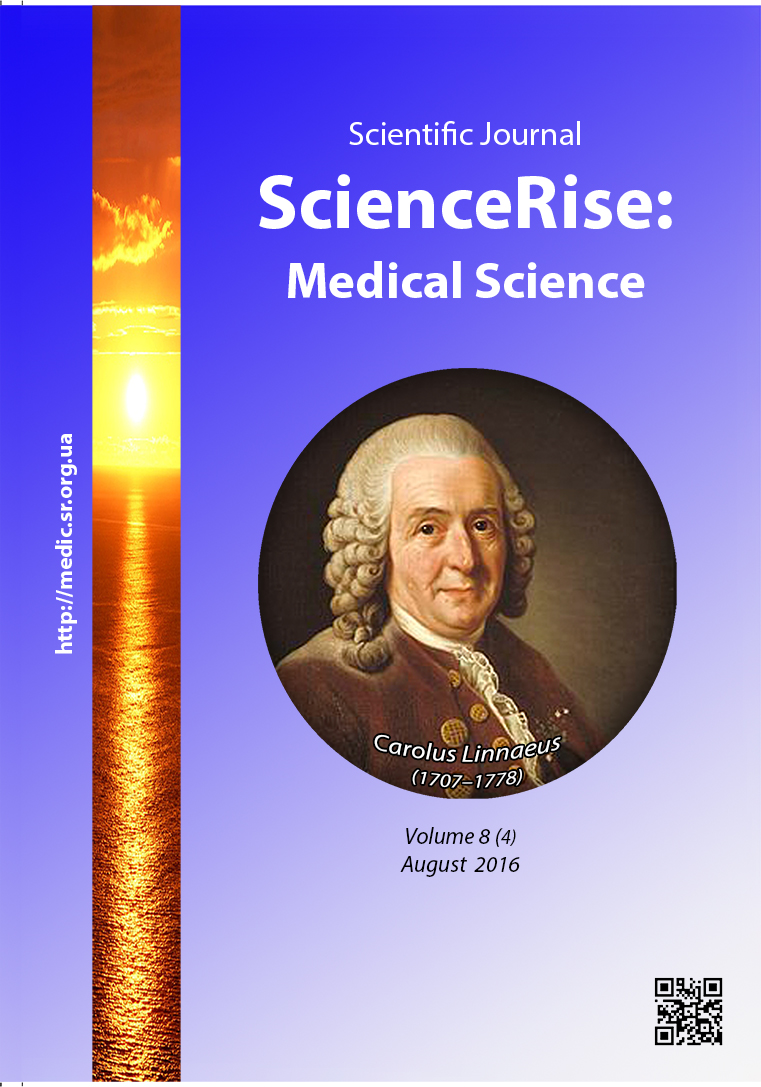Studying of vertigo in acute ischemic brain disorders in the vertebrobasilar system
DOI:
https://doi.org/10.15587/2519-4798.2016.76477Keywords:
Vertigo, acute cerebral ischemia, vertebrobasilar system, Doppler ultrasound, MRI studyAbstract
The work is devoted to the study of vertigo in patients with acute ischemic brain disorders.
The purpose of the study – studying the role of acute cerebral ischemia in the formation of vertigo in patients with focal and transient ischemic deficits in the vertebrobasilar system.
Material and methods. The study is based on the results of a prospective analysis of 37 patients with acute cerebral pathology in vertebrobasilar territory. The patients were examined and treated in the neurological departments "Kharkiv State Clinical Hospital №7». We used clinical and neurological method, investigated the condition of the main arteries of the head, digital ultrasonic diagnostic scanning system. Brain structure was investigated on MRI.
The study showed, that in acute manifestations of vascular disease in the vertebrobasilar system isolated vertigo is rare, most often a combination of vertigo occurs with neurological symptoms.
Neuroimaging results did not conclusively interpreted the relationship of dizziness with acute cerebral ischemia in the vertebrobasilar system; further research with the assistance of modern technology in the form of magnetic resonance angiography of brain vessels, duplex ultrasonography, and statistical methods.
The prevalence of high degree of stenosis (50% to 85%) of arteries of vertebrobasilar system at the ultrasound indicates a high risk of stroke in the population and the need to optimize the preventive measures.
To solve the problems of early diagnosis and prevention of vertigo in acute ischemic cerebral disorders the program of preventive measures cerebrovascular disease should include screening ultrasound for the detection of this pathology already at an early (asymptomatic) stage of the diseaseReferences
- Damulin, I. V., Ekusheva, E. V. (2014). Stroke and neuroplasticity. Zhurnal Nevrologii i Psikhiatrii Im. S. S. Korsakova, 114 (12), 136. doi: 10.17116/jnevro2014114121136-142
- Edlow, J. A., Newman-Toker, D. (2016). Using the Physical Examination to Diagnose Patients with Acute Dizziness and Vertigo. The Journal of Emergency Medicine, 50 (4), 617–628. doi: 10.1016/j.jemermed.2015.10.040
- Lee, S.-H., Kim, J.-S. (2015). Acute Diagnosis and Management of Stroke Presenting Dizziness or Vertigo. Neurologic Clinics, 33 (3), 687–698. doi: 10.1016/j.ncl.2015.04.006
- Abdulina, O. V. (2008). Frequency, causes, differential diagnosis, treatment and prognosis of acute vestibular vertigo in the emergency neurology. Moscow, 32.
- Park, H., Kim, H., Cha, M., Koh, I. (2013). Vertigo. Yonsei Med J., 54 (6), 1538–1541.
- Alekseeva, N. S. (2005). Lack of blood flow in the vertebrobasilar system and peripheral cochleovestibular syndromes. Atmosphere-Nervous Diseases, 1, 20–24.
- Caplan, L. R., Wityk, R. J., Glass, T. A. et. al. (2004). New England Medical Center Posterior Circulation Registry. Ann. Neurol, 56, 389−398.
- Newman-Toker, D. E., Hsieh, Y.-H., Camargo, C. A., Pelletier, A. J., Butchy, G. T., Edlow, J. A. (2008). Spectrum of Dizziness Visits to US Emergency Departments: Cross-Sectional Analysis From a Nationally Representative Sample. Mayo Clinic Proceedings, 83 (7), 765–775. doi: 10.4065/83.7.765
- Kerber, K. A., Brown, D. L., Lisabeth, L. D., Smith, M. A., Morgenstern, L. B. (2006). Stroke Among Patients With Dizziness, Vertigo, and Imbalance in the Emergency Department: A Population-Based Study. Stroke, 37 (10), 2484–2487. doi: 10.1161/01.str.0000240329.48263.0d
- Zamergrad, M. V. (2015). Age-related aspects of diagnosis and treatment of vertigo. Moscow, 243.
- Parfenov, V. A., Bestuzhev, N. V. (2012). Diagnosis and treatment of vertigo in outpatients. Doctor, 12, 18−21.
- Parfenov, V. A., Zamergrad, M. V., Melnikov, O. A. (2011). Vertigo: Diagnosis and Treatment, common diagnostic mistakes. Moscow: Medical Information Agency, 192.
- Zhuravleva, M. V. (2011). Modern aspects of treatment of vestibular and coordination disorders. Consilium Medicum Ukraina, 2, 22−26.
- Parfenov, V. A., Abdulina, O. V., Zamergrad, M. V. (2005). Peripheral vestibulopathy under the guise of stroke. Journal of Neurology, 6, 28−32.
- Parfenov, V. A., Zamergrad, M. V., Melnikov, O. A., Batysheva, T. T. (2011). Vertigo. Guidelines. Medical News Agency. Moscow, 14.
- Yavorskaya, V. A., Hvisyuk, V. V., Cooper, O. B. et. al. (2015). Clinical and pathologic comparison of different subtypes of ischemic stroke. Ukrainsky News of Psihonevrology, 23, 53−57.
- Treschinskaya, M. A. (2008). Modern possibilities of the complex therapy of hypertensive encephalopathy. News of Medicine and Pharmacy in Ukraine, 2 (233).
- Oshchepkova, E. V. (2004). Hypertensive encephalopathy. Consilium Medicum, 3 (3).
- Homazyuk, T. A., Egorov, K. Y. (2010). General practice. Health Protection of Ukraine XXI century, 3 (14), 25−26.
- Howell Collie, M. J., Ramsey, A. R. (2014). Differentiating Benign Paroxysmal Positional Vertigo From Other Causes of Dizziness. The Journal for Nurse Practitioners, 10 (6), 393–400. doi: 10.1016/j.nurpra.2014.03.008
Downloads
Published
How to Cite
Issue
Section
License
Copyright (c) 2016 Svitlana Fedorchenko

This work is licensed under a Creative Commons Attribution 4.0 International License.
Our journal abides by the Creative Commons CC BY copyright rights and permissions for open access journals.
Authors, who are published in this journal, agree to the following conditions:
1. The authors reserve the right to authorship of the work and pass the first publication right of this work to the journal under the terms of a Creative Commons CC BY, which allows others to freely distribute the published research with the obligatory reference to the authors of the original work and the first publication of the work in this journal.
2. The authors have the right to conclude separate supplement agreements that relate to non-exclusive work distribution in the form in which it has been published by the journal (for example, to upload the work to the online storage of the journal or publish it as part of a monograph), provided that the reference to the first publication of the work in this journal is included.









